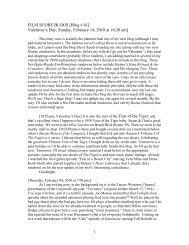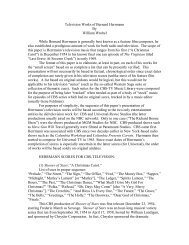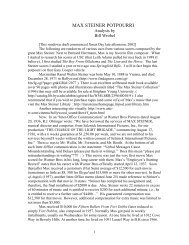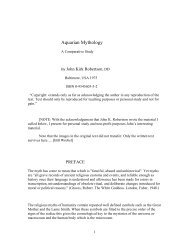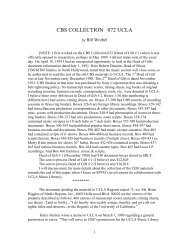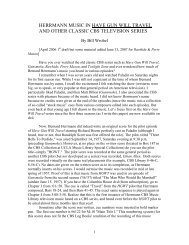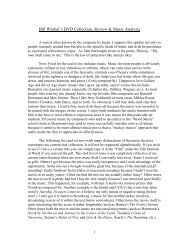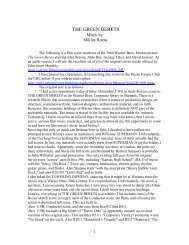FAHRENHEIT 451 - Film Score Rundowns
FAHRENHEIT 451 - Film Score Rundowns
FAHRENHEIT 451 - Film Score Rundowns
You also want an ePaper? Increase the reach of your titles
YUMPU automatically turns print PDFs into web optimized ePapers that Google loves.
“The Bedroom” Cue XII [5M1] Lento in C time, 44 bars, 1:32. Pages 22<br />
thru 27 in the score. Track # 8 starting :00 thru 1:30. Dvd chapter 5 starting at 5:30.<br />
Scene: Much revived, Linda tears herself away from the television for a change and<br />
seduces Montag in the bedroom.<br />
Interesting musical construction. Herrmann has the violins I top staff and top<br />
staff celli playing the melody line in quarter note triplet value (three quarter notes equals<br />
half a bar in C time) in the odd numbered bars, while violins I bottom staff and violas<br />
take over in the even bars. The harps play a fast arpeggio figure of 32 nd notes to<br />
arpeggiando quarter note chord.<br />
We find sords (muted) top staff violins I sul G playing f > Line 1 (top staff celli<br />
play small octave) triplet value F# half note to triplet value G quarter note to next half bar<br />
figure of D# half to E quarter notes (again, triplet value). In Bar 2, bottom staff violins I<br />
sul D and top staff violas (small octave register) take over that F#-G to D#-E phrase p<br />
crescendo. Back in Bar 1,bottom staff sords celli play forte > the Great octave range E<br />
half note up to B half note (repeat next bar). After an 8 th rest, top staff of sords Violins II<br />
play the small octave B (b) dotted quarter note forte decrescendo, then (after an 8 th rest)<br />
another B dotted quarter note, mf >. Bottom staff violins II play small octave G dotted<br />
quarter notes (repeated next bar). Bottom staff violas play, after an 8 th rest, small octave<br />
E dotted quarter note (repeat pattern in the same bar and repeat next bar).<br />
Harp I top staff (treble clef) plays mezzo-forte (mf) a descending to ascending<br />
32 nd note figure (quarter note value) of Line 1 F#-D-B-G-F#-(now ascending)-G-B-D<br />
(essentially the G maj 7). This moves immediately into the Great Staff (both staves) E<br />
min 9 quarter note chord played as an arpeggiando (wavy vertical line rolled chord) on<br />
notes (E/G/B/D/F#). The actual notes are (bottom staff) Great octave E/B/small octave<br />
D/F# and (top staff) G/B/Line 1D/F#. Two quarter rest marks follow. Harp II bottom<br />
staff (bass clef) plays contrary motion or ascending-descending 32 nd notes Great octave<br />
E-G-B-D up to F# (now descending) D-B-G to the exact same arpeggiando of harp I.<br />
Repeat next bar. The vibe strikes a soft piano level Line 1 F# half note in Bar 1 only (not<br />
Bar 2).<br />
In Bar 3, the harp plays the descending-ascending 32 nd note figure on Line 1 E-C-<br />
A-F-E (now rising) F-A-C (essentially the F maj 7 sound). Then the harpist fingers the D<br />
min 9 th (D/F/A/C/E) quarter note chord (actual notes D/AE/F/A/C/E). Harp II plays<br />
rising notes D-A-C-E-F to descending E-C-A to arpeggiando as above. The vibe sounds<br />
the E half note.<br />
Top staff violins I and celli play “3” triplet value Line 1 (small octave for VC) E<br />
half note to F quarter note, then triplet value middle C# half note to D quarter note, p




